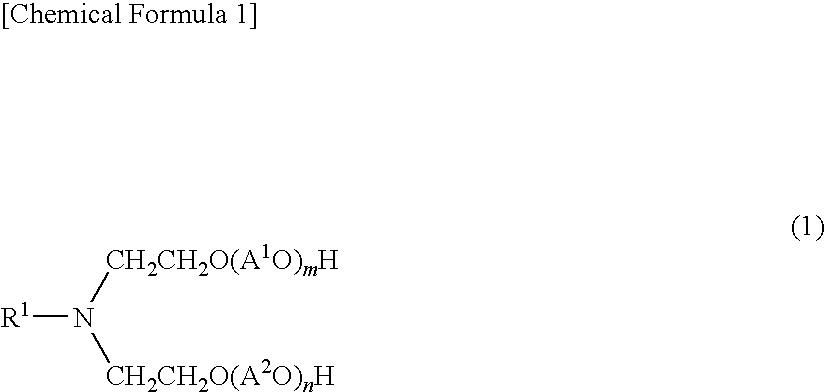Aliphatic amine alkylene oxide adduct
a technology of aliphatic amine and alkylene oxide, which is applied in the field of aliphatic amine alkylene oxide adduct, can solve the problems of further worsening color, generation of impurities, and inconvenient use, and achieves the effects of low impurities or coloration, low cost, and high purity
- Summary
- Abstract
- Description
- Claims
- Application Information
AI Technical Summary
Benefits of technology
Problems solved by technology
Method used
Image
Examples
example 1
[0082]222 g (1.2 moles) of laurylamine (FARMIN 20D, manufactured by Kao Corporation) was introduced into a 1-L autoclave, and the autoclave was purged with argon gas and then depressurized, and the temperature was elevated to 95° C. At the same temperature, 105.6 g of ethylene oxide (2.4 moles, 2.0 moles relative to 1 mole of amine) was slowly added dropwise, while the internal pressure of the autoclave was maintained not to exceed 0.3 MPa. After an induction period of about 1.5 hours, the temperature was controlled in the range of 90 to 110° C., and the system was allowed to react for 4 hours in total. After completion of the dropwise addition, the reaction was carried out at 95° C. for 30 minutes until the internal pressure of the autoclave reached the same pressure as that at the time of initiation of dropwise addition.
[0083]3.2 g of a 25% aqueous solution of tetramethylammonium hydroxide was added to the resulting ethylene oxide 2.0-mole adduct of laurylamine while preventing ai...
example 2
[0086]191 g (1.0 mole) of coconut (coconut oil) amine (FARMIN CS, manufactured by Kao Corporation) was introduced into a 1-L autoclave, and the autoclave was purged with argon gas and then depressurized, and the temperature was elevated to 95° C. At the same temperature, 88 g of ethylene oxide (2.0 moles, 2.0 moles relative to 1 mole of amine) was slowly added dropwise, while the internal pressure of the autoclave was maintained not to exceed 0.3 MPa. After an induction period of about 1.5 hours, the temperature was controlled in the range of 90 to 110° C., and the system was allowed to react for 4 hours in total. After completion of the dropwise addition, the reaction was carried out at 95° C. for 30 minutes until the internal pressure of the autoclave reached the same pressure as that at the time of initiation of dropwise addition.
[0087]3.2 g of a 25% aqueous solution of tetramethylammonium hydroxide was added to the resulting ethylene oxide 2.0-mole adduct of coconut amine while ...
example 3
[0090]207.2 g (0.8 moles) of hardened beef tallow amine (AMINE ABT-R, manufactured by Nippon Oil & Fats Co., Ltd.) was introduced into a 1-L autoclave, and the autoclave was purged with argon gas and then depressurized, and the temperature was elevated to 95° C. At the same temperature, 70.4 g of ethylene oxide (1.6 moles, 2.0 moles relative to 1 mole of amine) was slowly added dropwise, while the internal pressure of the autoclave was maintained not to exceed 0.3 MPa. After an induction period of about 2 hours, the temperature was controlled in the range of 90 to 110° C., and the system was allowed to react for 5 hours in total. After completion of the dropwise addition, the reaction was carried out at 95° C. for 30 minutes until the internal pressure of the autoclave reached the same pressure as that at the time of initiation of dropwise addition.
[0091]4.2 g of a 25% aqueous solution of tetramethylammonium hydroxide was added to the resulting ethylene oxide 2.0-mole adduct of hard...
PUM
| Property | Measurement | Unit |
|---|---|---|
| color | aaaaa | aaaaa |
| Gardner color scale | aaaaa | aaaaa |
| aliphatic amine | aaaaa | aaaaa |
Abstract
Description
Claims
Application Information
 Login to View More
Login to View More - R&D
- Intellectual Property
- Life Sciences
- Materials
- Tech Scout
- Unparalleled Data Quality
- Higher Quality Content
- 60% Fewer Hallucinations
Browse by: Latest US Patents, China's latest patents, Technical Efficacy Thesaurus, Application Domain, Technology Topic, Popular Technical Reports.
© 2025 PatSnap. All rights reserved.Legal|Privacy policy|Modern Slavery Act Transparency Statement|Sitemap|About US| Contact US: help@patsnap.com



